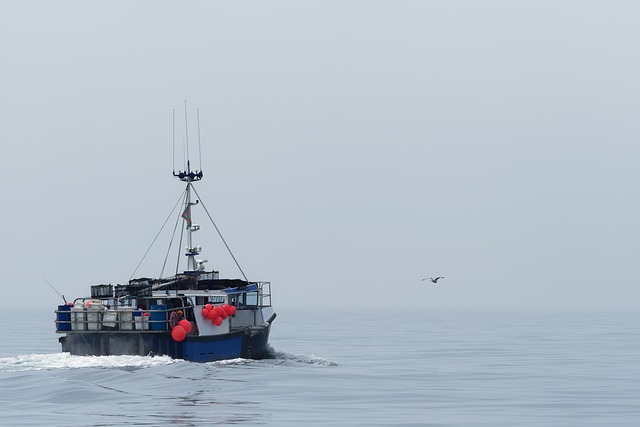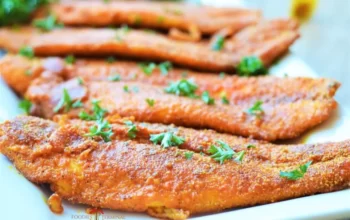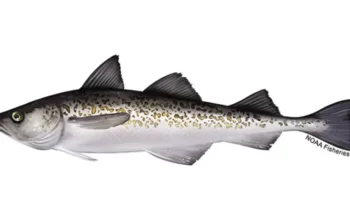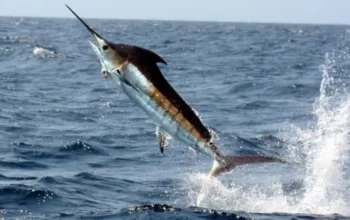A straightforward explanation of fishing leaders is provided in this article. It contains details on the various kinds of fishing leaders you can purchase as well as the benefits of using one.
A fishing leader is, in essence, the portion of your fishing line that comes before your hook. It is typically a different material from your main line and serves a variety of functions.
The difference between a successful fishing trip and going home empty-handed can be made by knowing what a fishing leader is and how to attach one.
Table of Contents
What is a Leader?
A fishing leader is a brief, particularly sturdy piece of line that you attach between the end of your main line and your lure and hook. Although less obvious to fish, your main fishing line is more durable and less likely to break. A leader can range in length from 12 prime feet to more than 20 prime feet.
If you want to start fishing right away, you could just tie the lure or hook to the end of your main fishing line. However, using a fishing leader has many advantages and greatly improves your chances of success.
Types of Fishing Leaders
There are various kinds of fishing leaders available, and the one you use will depend on a number of variables. The majority of applications involve these kinds.
Standard Monofilament Leader
A single strand of robust, thinly spun line is used in a standard monofilament leader. Standard monofilament leaders typically have properties like water absorption, abrasion resistance, some stretch, and solar absorption.
Standard monofilament leaders are reasonably priced. They are also flexible, making it simple to work with them when tying different knots. They offer excellent resistance to abrasion, and the slight stretch they have allows them to take the blow of a fish that is aggressive.
There are some drawbacks to these leaders that need to be considered. They deteriorate with UV light exposure over time because they absorb sunlight. To feel smaller bites can be difficult due to their ability to stretch.
Fluorocarbon Monofilament Leader
A single strand of monofilament is also used in fluorocarbon leaders, but due to some important variations, these leaders are more expensive. These leaders have less stretch, less visibility to fish, and less porosity.
Since fluorocarbon leaders don’t stretch much, it’s simpler to detect smaller bites. The knot strength on these leaders is excellent, and they are even more abrasion-resistant. Leaders made of fluorocarbon don’t corrode under UV light or absorb water.
Fluorocarbon leaders have only a few minor drawbacks, including being slightly more expensive and having a propensity to sink in water.
Wire Fishing Leader
The single-strand, multi-strand, and knottable varieties of wire fishing leaders are available in a range of sizes and lengths. Compared to other types of leaders, wire leaders are less transparent, but they are more robust when attempting to snag large fish with razor-sharp teeth.
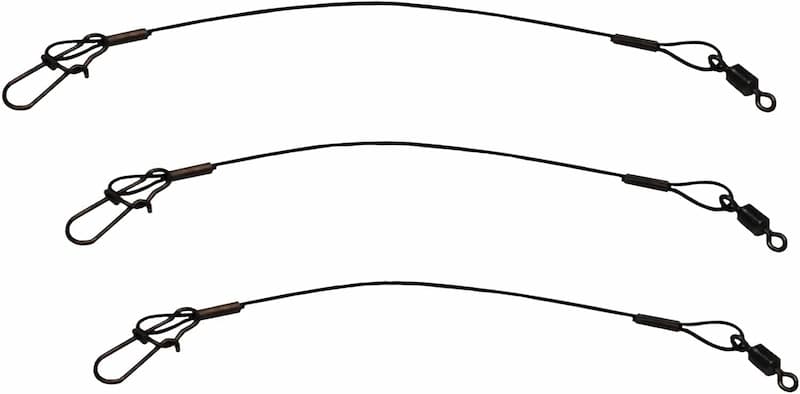
What Does a Leader Do in Fishing?
Fishing leaders have several purposes:
- Toprotect the line from breakages, snags or abrasion.
- the line from becoming twisted, tangled, or kinked.
- to prevent spooking the fish with a nearly undetectable wire.
- for the purpose of causing the fishing wire to sink.
- being able to cast large, heavy leaders without the line snapping.
- so that you have more authority over your line.
- to assist you in casting farther and more precisely.
- so that fishing will be simpler.
Main Benefits of Fishing Leaders
All fishing leaders have advantages over using only a main fishing line, but the advantages will vary depending on the kind of fishing leader you pick.
However, regardless of the type, there are two main advantages you can anticipate from a leader.
Lower Chance of Breaking
Depending on where you are fishing, there may be sharp rocks and barnacles covering the bottom. These circumstances have the potential to snare your line. Main fishing lines frequently can’t withstand rubbing repeatedly on rough terrain.
Some fish have rows of pointed teeth as well, making them difficult to catch with just the main fishing line. Fishing leaders made of monofilament are stretchable and resistant to abrasion, so they won’t break.
Better Bait Presentation
The right fishing leader can practically disappear for fish, increasing your chance that they’ll take the bait.
Light travels quickly through fluorocarbon monofilament leaders because of their close refraction to that of water. When fishing in crystal-clear water, this kind of leader is very productive.
When Do I Need a Leader?
The quick response is that using a fishing leader is never a bad idea. The majority of the time when an angler is fishing, they will use one.
The best course of action would be to employ a fishing leader any time you feel the need to fortify or protect your primary fishing line. In extremely clear water, using a fishing leader will also improve the presentation of the bait.
Read about What Is A Jetty?
How to Attach Leaders?
The best way to attach a fishing leader to your line will depend on the type of fishing you’re doing, the conditions of the water, and the species of fish you’re after.
The approach that works best for you is ultimately the best approach to use.
Knots
For securing a fishing leader to your main fishing line, there are two main knots that anglers frequently employ. The albright and double uni knots are these.
The albright knot is regarded as the most trustworthy knot for tying on a leader by the majority of anglers. When joining monofilament and braided lines with different diameters, anglers frequently use it.
I personally prefer to use the double uni knot
Additionally, you can use it to join monofilament to wire and make shock leaders.
How to tie an albright knot:
- Make a loop at the end of the heavier line, and use your thumb and forefinger to hold it in place.
- Through the top of the loop, thread about 10 inches of the lighter line.
- Together with the two heavier strands of the loop, clasp the lighter line’s tag end. Ten times or so, tightly wrap the lighter line around the three strands, wrapping it toward the loop’s end.
- The lighter line’s tag end should be inserted through the loop’s underside. The lighter line will enter and leave the loop from the same side.
- Slide the wrapped lighter line toward the end of the loop while maintaining control of the heavy line. Pull firmly on the lighter line’s strands and the ends of the heavier line. Ensure that it is firmly pulled in place.
- After tying the knot, trim the lines’ tag ends.
The double uni knot is a straightforward knot used to attach a fishing leader with a loop to the main fishing line.
Complete instructions and step-by-step pictures are available here.
A strong connection between your fishing line and leader should be made using either of these knots. Using only a knot to join your lines won’t lessen the possibility of line twisting, it’s important to remember that.
Swivels
A swivel is a tool that makes use of two rings joined by a pivoting joint. A swivel can be used to join one length of line to another.
Because they prevent line twisting, swivels are useful for attaching leaders to fishing lines.
Depending on the kind of fishing you’re doing and the type of bait you’re using, you might or might not use a swivel to secure your leader. A swivel shouldn’t necessarily be used in every situation.
When line twisting is your main concern, such as when using bait or a lure that will likely twist, you should think about using a swivel. The best option is to use a regular knot attachment if you aren’t worried about the line twisting.
Swivels will add a little weight, making more delicate lines even more flimsy. A swivel requires two knots, so it takes a little bit longer to connect with one than it does with a knot.
For most fishing leaders, the main fishing line can be attached with just one swivel. The best location for your swivel is at the top of your fishing leader, far from your lure or bait.
The offshore swivel knot is the most reliable type of knot to use when connecting a swivel to your fishing line’s leader. This knot’s main advantage is its propensity for both strands to hold even if one of them breaks.
How to tie an offshore swivel knot:
- Double-line leader’s loop should be threaded through the swivel’s eye. To make a single twist between the loop’s end and the swivel’s eye, rotate the loop’s end.
- Fold the loop around the swivel and the two lines. Hold the loop firmly against the double line’s two strands.
- The two loops will twist together if you turn the swivel through their middles about six to seven times.
- Holding onto the double-line strands while releasing the end of the loop is a good idea. To tighten the knot, pull the swivel and the double-line strands.
- To complete the connection, use pliers to hold the other end of the swivel, then tightly grasp the double-line strands and pull the loops toward the swivel.
To connect the line to the swivel, repeat the procedure for the knot at the opposite end. Now that your fishing leader is securely fastened, you shouldn’t have to be concerned about potential line-twisting issues.
What Problems Do Fishing Leader Lines Solve?
Anglers can run into issues when fishing, and leader lines are a great way to fix them. You must decide what issues you’ll encounter before you start creating leader lines.
For instance, codfish tend to hide in very rocky terrain at the ocean’s bottom when they are being pursued by fishermen. If your fishing line rubs against one of these rocks, it may break because the rock is very sharp. Codfish also have razor-sharp teeth that can cut through fishing line.
Consider the potential circumstances that your line may encounter.
Don’t worry; I’ve got you covered if you need help trying to think of potential conditions that you should try to consider.
The following are some things that I frequently encounter.
Avoid Line Breaks
The abuse your line endures while submerged is simple to overlook. The majority of people frequently underestimate the quantity of sharp underwater objects, such as rocks, barnacles, shells, reefs, etc.
Oh, did I forget to mention that some fish have teeth that are so sharp they can sever your fishing line?
Many of these problems will be resolved by choosing the right fishing line. Typically fishing lines with a higher pound test will have larger diameters. This gives the line “more meat” that has to be cut through.
Fishing lines made of monofilament are very resistant to abrasion. Abrasion resistance refers to the fishing line’s ability to withstand being rubbed against a rough surface.
Avoid Snags
There will be plenty of snags to deal with if you are fishing in or near rocky terrain or areas with a lot of organic growth.
The majority of snags happen when the hook hooks a rock or an organic growth, and inexperienced anglers make mistakes by not jigging the rod hard enough.
You can only continue fishing if you want to address your lack of experience. The hook can be removed from the rocks and growth, though, if you take certain steps.
Your chances of getting snagged will be significantly reduced by making your leaders in a way that lifts your hook off the water. The “drop shot” is a useful illustration of a fishing leader configuration.
Reduce Line Visibility
Every fish will react differently to a bait. Some fish attack anything that moves vigorously. Before striking, some people will examine the bait.
If they see the fishing line attached to the bait, some fish won’t take the bait. So, if you want the best bait presentation possible, a leader made of fluorocarbon fishing line is your best option.
When submerged, fluorocarbon fishing line is transparent to light. Fish can essentially not see the line as a result.
Because of this, if you are concerned about how the bait will present itself, using fluorocarbon as your fishing leader line would be the best option.
Avoid Line Twist With Swivels
If you got a fish on the hook, the fish will be thrashing around creating line twist. In some instances, line twist can make your fishing line so fragile that it can break.
The solution to this is to swivel-attach your leader line before tying it to your main fishing line. A swivel will enable free rotation of your leader line without twisting your main fishing line.
FAQs
Do You Need a Leader for Saltwater Fishing?
For saltwater fishing, leader lines are necessary. Fish from the sea are typically bigger, more powerful, and equipped with numerous teeth. You will lose a lot of fish if you don’t choose a leader line that can handle the strain it will endure.
Should I Use Mono Or Fluorocarbon Leader?
When you need a lighter line for a more natural bait presentation and stretch to serve as a shock absorber, you should use monofilament leaders. Fluorocarbon leaders are heavier and stiffer, which can result in an unnatural presentation of the bait, but this is great for the presentation of the bait because these lines are difficult to see underwater.
What is a Leader in Fishing?
A leader line is simply a section of fishing line with a hook or lure attached to one end and a fishing line of the same or different strength or type on the other. The other end is joined to the main line. Usually, one know or swivel is used to join the leader line to the main line.
Can You Use Braided Line as a Leader?
Undoubtedly, a leader line made of braided line can be used. When you don’t care about abrasion or line visibility, braided line works best as a leader. It should be a little weaker braided line than your main line.
Fishing Leaders for Beginners
The fundamentals of knowing which fishing leader to use and why are now familiar to you. It might appear to be a lot to process. However, you will become more adept at selecting leaders the more you practice. If you don’t have any experience, it would be best to stick to the fundamentals of fishing.
Anglers who use spinning or baitcasting rods frequently opt for leaders that are between 13 and 30 inches long. For long casts or when fishing for fish with keen vision, large leaders are ideal. In contrast, shorter ones are preferable for casting precision and fishing in weedy areas.
The thickness of the fishing leader will vary depending on the fish you are pursuing and the pound test of the fishing line. Typically, a leader is used that is the same pound test and diameter as the main fishing line. However, there may be circumstances where you need more strength at the very end of the line.
It’s not difficult at all to rig a leader. There are numerous options available. But using swivels at both ends is the best strategy. You won’t need to cut the main fishing line if the leader breaks this way. Additionally, leaders with swivels avoid line twist, which is a fairly common occurrence when battling fish with a lot of movement. Yet only you have the final say. So join in the discussion and let us know which fishing leader you think is the best!

